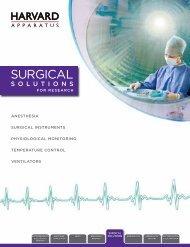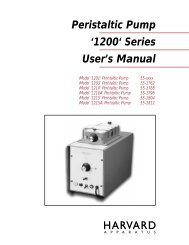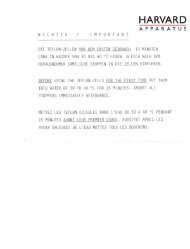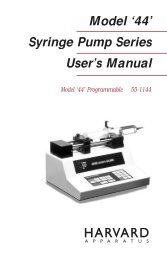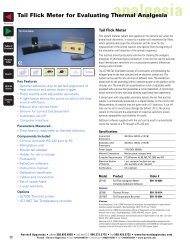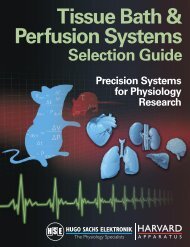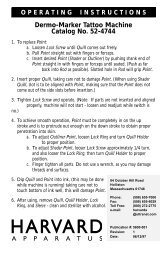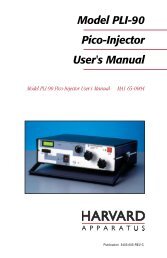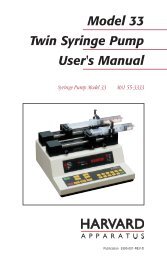Research Grade Isotonic Transducer User's Manual - Harvard ...
Research Grade Isotonic Transducer User's Manual - Harvard ...
Research Grade Isotonic Transducer User's Manual - Harvard ...
Create successful ePaper yourself
Turn your PDF publications into a flip-book with our unique Google optimized e-Paper software.
<strong>Research</strong> <strong>Grade</strong><br />
<strong>Isotonic</strong> <strong>Transducer</strong><br />
<strong>User's</strong> <strong>Manual</strong><br />
<strong>Research</strong> <strong>Grade</strong> <strong>Isotonic</strong> <strong>Transducer</strong>, 110 VAC/60 Hz<br />
MA1 72-4486<br />
<strong>Research</strong> <strong>Grade</strong> <strong>Isotonic</strong> <strong>Transducer</strong>, 220 VAC/50 Hz<br />
MA1 72-4487<br />
Publication 5408-001-REV-A
WEEE/RoHS Compliance Statement<br />
EU Directives WEEE and RoHS<br />
To Our Valued Customers:<br />
We are committed to being a good corporate citizen. As part of that commitment,<br />
we strive to maintain an environmentally conscious manufacturing operation. The<br />
European Union (EU) has enacted two Directives, the first on product recycling<br />
(Waste Electrical and Electronic Equipment, WEEE) and the second limiting the use<br />
of certain substances (Restriction on the use of Hazardous Substances, RoHS).<br />
Over time, these Directives will be implemented in the national laws of each EU<br />
Member State.<br />
Once the final national regulations have been put into place, recycling will be offered<br />
for our products which are within the scope of the WEEE Directive. Products falling<br />
under the scope of the WEEE Directive available for sale after August 13, 2005 will<br />
be identified with a “wheelie bin” symbol.<br />
Two Categories of products covered by the WEEE Directive are currently exempt<br />
from the RoHS Directive – Category 8, medical devices (with the exception of<br />
implanted or infected products) and Category 9, monitoring and control instruments.<br />
Most of our products fall into either Category 8 or 9 and are currently exempt from<br />
the RoHS Directive. We will continue to monitor the application of the RoHS<br />
Directive to its products and will comply with any changes as they apply.<br />
• Do Not Dispose Product with Municipal Waste<br />
• Special Collection/Disposal Required
1<br />
Table of Contents<br />
<strong>Harvard</strong> Apparatus <strong>Research</strong> <strong>Isotonic</strong> <strong>Transducer</strong> User’s <strong>Manual</strong><br />
SUBJECT<br />
PAGE NO.<br />
Warranty and Repair Information ........................2<br />
Theory of Operation ..............................................3<br />
General Information:<br />
Specifications......................................................4<br />
Amplifier/Power Supply ......................................4<br />
Internal Controls and Adjustments ....................5<br />
Electrical Output ................................................5<br />
Maintenance and Storage ..................................5<br />
Serial Number ....................................................5<br />
Operations:<br />
<strong>Transducer</strong> Setup ..............................................6<br />
Smoot Muscle/Isolated Organ Preparation ........7<br />
Skeletal Muscle Preparation ..............................8<br />
Publication 5408-001-REV-A
2<br />
General Information<br />
<strong>Harvard</strong> Apparatus <strong>Research</strong> <strong>Isotonic</strong> <strong>Transducer</strong> User’s <strong>Manual</strong><br />
Serial Numbers<br />
All inquires concerning our product should refer to the serial number of the unit(s).<br />
Warranty<br />
<strong>Harvard</strong> Apparatus warranties the instrument(s) for a period of two years from date of<br />
purchase.At its option,<strong>Harvard</strong> Apparatus will repair or replace the unit(s) if it is found<br />
to be defective as to workmanship or material.<br />
This warranty does not extend to damage resulting from misuse, neglect or abuse,normal<br />
wear and tear, or accident.<br />
This warranty extends only to the original customer purchaser.<br />
IN NO EVENT SHALL HARVARD APPARATUS BE LIABLE FOR INCIDENTAL OR<br />
CONSEQUENTIAL DAMAGES. Some states do not allow exclusion or limitation of<br />
incidental or consequential damages so the above limitation or exclusion may not<br />
apply to you. THERE ARE NO IMPLIED WARRANTIES OF MERCHANTABILITY,<br />
OR FITNESS FOR A PARTICULAR USE, OR OF ANY OTHER NATURE. Some states<br />
do not allow this limitation on an implied warranty, so the above limitation may not<br />
apply to you.<br />
If a defect arises within the two-year warranty period, promptly contact <strong>Harvard</strong><br />
Apparatus, Inc. 84 October Hill Road, Holliston, Massachusetts 01746-1371<br />
using our U.S. only toll free number 1-800-272-2775 or dial (508) 893-8999. Goods will<br />
not be accepted for return unless an RMA (returned materials authorization) number<br />
has been issued by our customer service department.The customer is responsible for<br />
shipping charges. Please allow a reasonable period of time for completion of repairs,<br />
replacement and return. If the unit is replaced, the replacement unit is covered only<br />
for the remainder of the original warranty period dating from the purchase of the original<br />
device.<br />
This warranty gives you specific rights, and you may also have other rights which vary<br />
from state to state.<br />
Repair Facilities and Parts<br />
<strong>Harvard</strong> Apparatus stocks replacement and repair parts. When ordering, please<br />
describe parts as completely as possible, preferably using our part numbers. If practical,<br />
enclose a sample or drawing.We offer a complete reconditioning service.<br />
CAUTION: Not for clinical use on human patients.<br />
Publication 5408-001-REV-A
3<br />
Theory of Operation<br />
<strong>Harvard</strong> Apparatus <strong>Research</strong> <strong>Isotonic</strong> <strong>Transducer</strong> User’s <strong>Manual</strong><br />
This <strong>Isotonic</strong> <strong>Transducer</strong> converts rotary motion into a proportional DC voltage. A<br />
moveable capacitor plate attached to the rotating shaft and fixed capacitor plates form<br />
a differential capacitor. A patented electronic circuit, (U.S. Patent #4142144) transforms<br />
capacitance change linearity into a DC voltage equal to 5.0 volts for 15° of rotation.<br />
The use of the capacitance principle produces the following advantages:<br />
1) Extremely low moment of inertia of 0.36 cm which is an order of magnitude<br />
better than comparable units. This low inertia insures that complex quick<br />
changes are faithfully reproduced.<br />
2) Excellent linearity of ±1%.<br />
3) High voltage output, ±5.0 volts.<br />
4) Excellent stability and freedom from drift.<br />
0° = 0 voltage<br />
+ voltage<br />
– voltage<br />
Power Supply<br />
Signal Cable<br />
ISOTONIC<br />
TRANSDUCER<br />
VOLTS<br />
OUTPUT<br />
12 Volt AC Wall<br />
Transformer<br />
12 Volt AC<br />
Cable<br />
Figure 1. <strong>Research</strong> <strong>Grade</strong> <strong>Isotonic</strong> <strong>Transducer</strong><br />
Binding Posts<br />
Low-Gain Trim<br />
Offset Trim<br />
Publication 5408-001-REV-A<br />
_<br />
+
4<br />
General Information<br />
<strong>Harvard</strong> Apparatus <strong>Research</strong> <strong>Isotonic</strong> <strong>Transducer</strong> User’s <strong>Manual</strong><br />
Specifications<br />
Linearity ±1%<br />
Moment of Inertia<br />
Breakaway Torque<br />
Accuracy ±1%<br />
Rotation ±15°<br />
Output<br />
Sensitivity<br />
Output Impedance<br />
0.35 g•cm, without hardware<br />
0.05 g•cm<br />
±5.0 VDC for ±15° rotation<br />
1 minute of arc<br />
2 k ohms<br />
Amplifier/Power Supply<br />
a) The entire transducer is powered by a 12 volt AC wall transformer.<br />
b) There is no ON/OFF switch. The unit can remain powered, as shown on the<br />
digital meter, for the entire experiment.<br />
Signal Cable<br />
Power Supply<br />
ISOTONIC<br />
TRANSDUCER<br />
VOLTS<br />
OUTPUT<br />
12 Volt AC Wall<br />
Transformer<br />
12 Volt AC<br />
Cable<br />
Figure 1.Amplifier/Power Supply<br />
Publication 5408-001-REV-A
5<br />
General Information<br />
<strong>Harvard</strong> Apparatus <strong>Research</strong> <strong>Isotonic</strong> <strong>Transducer</strong> User’s <strong>Manual</strong><br />
Internal Controls and Adjustments<br />
On the rear panel of the power supply are three small access holes to the trim pots.<br />
The GAIN trim pot is accessed through the center hole and is factory set to deliver 5.0<br />
VDC for 15° of rotation. It can be adjusted to deliver between approx. 4 – 6 volts output<br />
as needed.<br />
The OFFSET adjustment trim pot is located on the extreme left and has been factory<br />
adjusted so that when the flat of the shaft is horizontal, output is zero volts. This can<br />
also be user adjusted as required.The right hole is not used.<br />
Electrical Output<br />
a) Binding post are provided on the power supply for output connections. Red<br />
is positive (+); black is negative (–) and also ground.<br />
b) Output voltage is ±5.0 VDC for rotation up to ±15°. Output impedance is 2<br />
kΩ for direct connection to all recorders.<br />
Figure 2. Electrical Output<br />
Maintenance and Storage<br />
a) No special precautions are required other than preventing corrosive solutions<br />
from entering the space where the output shaft exits the transducer.<br />
b) When not in use, store in a clean, dry place.<br />
Serial Number<br />
The serial number is located on the power supply circuit board. Refer to this number<br />
in any correspondence.<br />
Publication 5408-001-REV-A
6<br />
Operations<br />
<strong>Harvard</strong> Apparatus <strong>Research</strong> <strong>Isotonic</strong> <strong>Transducer</strong> User’s <strong>Manual</strong><br />
<strong>Transducer</strong> Setup<br />
This transducer is supplied with complete hardware to set up the transducer for<br />
smooth muscle, isolated organ, or exposed heart applications including bio-assay techniques<br />
in an organ bath, or skeletal muscle experiments such as the muscle twitch<br />
using the frog gastrocnemius preparation.<br />
The stainless steel mounting rod of the transducer should be securely fastened to a<br />
rigid stand for optimal use. It should be noted that maximum sensitivity to muscle<br />
movement occurs when the string connected to the muscle is closest to the rotating<br />
shaft. In this position, small movements create larger angular motion (see Fig. 1).<br />
When the lever is horizontal and in the same plane as the handle, the electrical output<br />
is zero (see Fig. 1). Clockwise rotation produces a positive voltage whereas counterclockwise<br />
rotation produces a negative voltage. The protecting ears of the handle<br />
bracket limit rotation to ±18°. In addition, there are internal limit stops.<br />
Lever Arm<br />
Nylon Screw<br />
Rotating Shaft<br />
+ voltage<br />
Mounting Rod<br />
0° = 0 voltage<br />
– voltage<br />
Figure 3.<strong>Transducer</strong> Setup<br />
Publication 5408-001-REV-A
7<br />
Operations<br />
<strong>Harvard</strong> Apparatus <strong>Research</strong> <strong>Isotonic</strong> <strong>Transducer</strong> User’s <strong>Manual</strong><br />
Smooth Muscle/Isolated Organ Preparation<br />
For smooth muscle or isolated organs preparations, the following items will be used:<br />
1) Simple Wooden or Aluminum Levers<br />
2) Lever-Holding Clamp<br />
To use the levers, the lever-holding clamp is attached to the shaft of the transducer<br />
using the Allen wrench provided. Make sure that the set screw seats on the flat portion<br />
of the shaft. The clamp must be attached to the shaft so that the Allen screw seats<br />
on the flattened portion of the shaft. The wooden or aluminum lever is passed<br />
through the hole in the clamp and is held in place by the spring of the clamp (see Fig.<br />
2).<br />
+ voltage<br />
Nylon Screw<br />
Allen Screw<br />
Mounting Rod<br />
0° = 0 voltage<br />
Lever Arm<br />
(Aluminum or Wood)<br />
– voltage<br />
Lever Clamp<br />
Figure 4. Smooth Muscle/Isolated Organ Preparation<br />
Publication 5408-001-REV-A
8<br />
Operations<br />
<strong>Harvard</strong> Apparatus <strong>Research</strong> <strong>Isotonic</strong> <strong>Transducer</strong> User’s <strong>Manual</strong><br />
Skeletal Muscle Preparation<br />
For skeletal muscle contraction the following items will be used:<br />
1) Muscle Lever<br />
2) After Loading Screw and Spring<br />
3) Scale Pan<br />
4) Weights<br />
Install after loading screw and spring as shown (see Fig. 3). Using an Allen wrench,<br />
install muscle lever so that Allen screw bears on shaft. Attach double hook to one of<br />
the two positions on the muscle lever and add the scale pan (see Fig. 3).<br />
High-Gain Trim<br />
Low-Gain Trim<br />
Offset Trim<br />
_<br />
Binding Posts<br />
+<br />
To <strong>Transducer</strong><br />
Sensing Head<br />
12 Volt AC input<br />
Figure 5. Skeletal Muscle Preparation<br />
Publication 5408-001-REV-A




